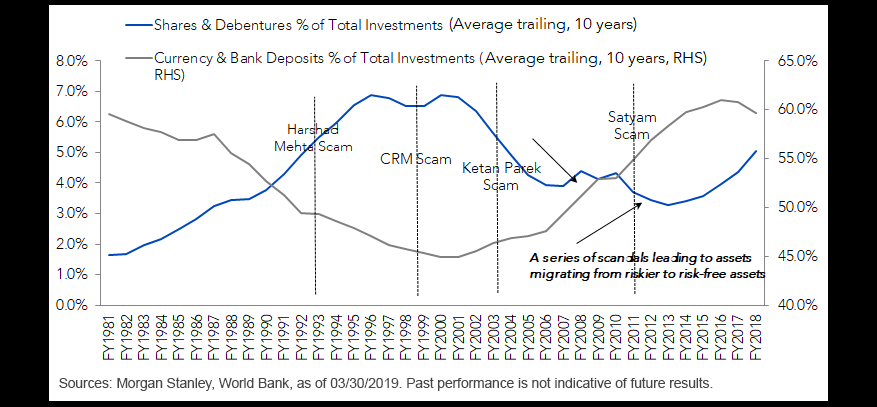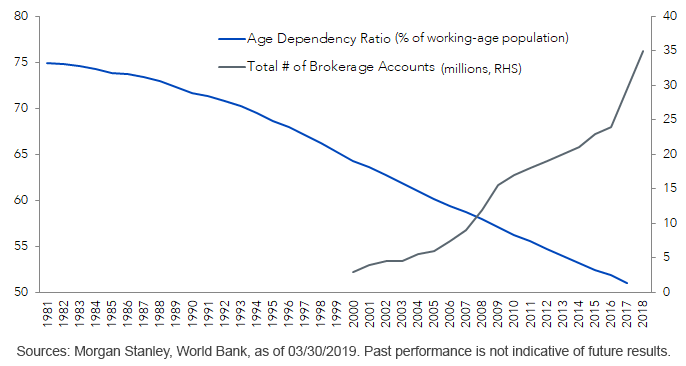The Case for India’s Multiple-Year Bull Market – Part 2


I recently wrote about how India’s structural changes are setting stocks up for a multiple-year bull run, covering structural changes by India’s Modi government.
Part 2 will cover a second fuel for Indian equities that could translate to market gains: inflows from domestic investors.
Traditionally, equity exposure has made up around 6% of Indian household balance sheets. By comparison, this figure in the United States has been well above 30%.1 This is about to change and, in my opinion, could set India up for a strategic bull run.
Great Reverse Migration from “Safer” Assets to Market Assets
India has a long stock market history. The Bombay Stock Exchange (BSE) was founded in 1875 and is the oldest stock exchange in Asia.2 Trading in India is now fully electronic, and the settlement process takes about 48 hours—as fast as any developed market.
But it’s been a long ride. Back in the 1990s and early 2000s, loosely regulated Indian markets were hit with multiple scandals. This led to the average Mr. & Mrs. Patel pulling out their precious savings from equities and putting them in safer instruments such as cash and bank accounts—a.k.a. the migration of Indian household assets.
Market Inefficiencies Lead to Migration of Household Assets from Securities to Cash and Bank Deposits

Please see glossary for definitions of terms in the chart.
Thus, while India’s per capita income increased fivefold, from a mere $247 in 1981 to $1,380 in 2018,3 its household investment in stock did not grow in proportion to its income!
As markets matured and became more regulated, this trend is now gradually changing.
What we now see is the reverse migration of household assets from safe cash and bonds toward equities.
The factors encouraging this reverse migration includes:
- A regulatory body, SEBI, has launched a series of stringent market regulations in the last two decades.
- A generation that has now grown up influenced by more regulated and audited markets.
- SEBI now mandates that all mutual funds spend 0.02% of their assets under management (AUM) on investor education. An equity asset base of Rupees 4,000 billion implies about Rs 800 million spent on investor education.4
Early Offshoots of Domestic Investment
Demographics and consumption have been core pillars of India’s economy. They are likely to fuel flows into stock markets, too.
Around 35 million new Indian brokerage accounts were opened in 20185—a record number. The growth trend is exponential. India has one of the most attractive demographic profiles, with nearly two-thirds of the country below 35 years of age.6 As memories of inefficient markets fade and the risk appetite of young India increases, we expect a significant shift toward stock market investments.
Young India Now Taking More and More Interest in Investing

Conclusion
It is estimated that India’s savings will increase fivefold over the next decade and reach over Rs 50 trillion by 2025.
Currently around 6% (or around Rs 900 billion in currency terms) of household balance sheets are in risky assets.7 Even if we assume there is no migration and this 6% stays flat, that implies Rs 3.08 trillion investments in market assets in the next eight to ten years.
An in-depth exposure to Indian markets could thus provide strategic growth.
The WisdomTree India Earnings Fund (EPI) is the first fund in the U.S. with physical access to India’s market under an exchange-traded wrapper. With exposure to over 200 profitable companies, EPI is, in my opinion, one of few funds with true exposure to India’s market, and now has a nearly 10-year track record.
1Sources: Reserve Bank of India (RBI), World Bank, as of 12/31/19
2Source: Bombay Stock Exchange (BSE), as of 12/31/18
3Source: World Bank, as of 12/31/18
4Source: Securities and Exchange Board of India (SEBI), as of 12/30/18
5Source: Morgan Stanley, as of 03/31/19
6Source: World Bank, as of 03/31/19
7A risk asset is any asset that carries a degree of risk. Risk asset generally refers to assets that have a significant degree of price volatility, such as equities, commodities, high-yield bonds, real estate and currencies
Important Risks Related to this Article
There are risks associated with investing, including possible loss of principal. Foreign investing involves special risks, such as risk of loss from currency fluctuation or political or economic uncertainty. This Fund focuses its investments in India, thereby increasing the impact of events and developments associated with the region, which can adversely affect performance. Investments in emerging, offshore or frontier markets such as India are generally less liquid and less efficient than investments in developed markets and are subject to additional risks, such as risks of adverse governmental regulation and intervention or political developments. As this Fund has a high concentration in some sectors, the Fund can be adversely affected by changes in those sectors. Due to the investment strategy of this Fund, it may make higher capital gain distributions than other ETFs. Please read the Fund’s prospectus for specific details regarding the Fund’s risk profile.


